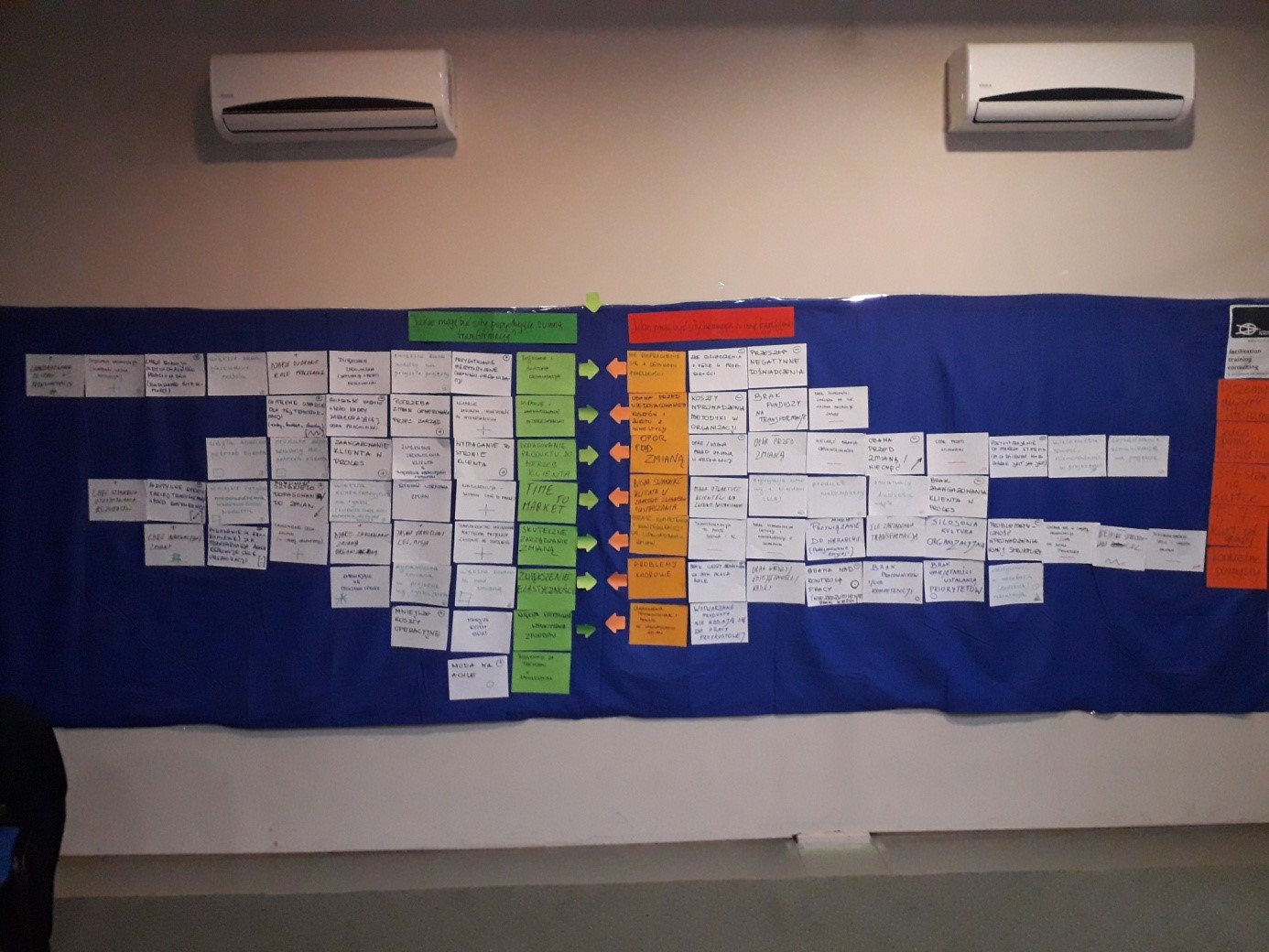15 04 2019 at 11:06
Facilitating Agility... and not only - by Artur Kasza
Group facilitation not new. one of its roots goes back to the activities of the Institute of Cultural Affairs (ICA) in the Unites States of America. Since the early 70’s, ICA has been involved in community development initiatives, first on the American continent and then globally. During that time, ICA developed a set of methods that are now a cornerstone in the foundations of group facilitation.
Another root is linked to IBM, which pioneered the use of facilitated group work in the form of joint application development sessions (JAD) around 1980. JAD workshops were highly structured events that brought together information technology professionals and users aiming to jointly define the requirements and specifications for an application or a system.
These events could take one or several days and were profoundly prepared to assure that the time allocated was optimally used. Then, JAD workshops were carried over into Rapid Application Design, and from there on, to the Dynamic Systems Development Method (DSDM), born in 1995. Currently, DSDM is a highly popular agile project management framework, branded by APMG as Agile Project Management.
In DSDM, facilitated workshops and the role of facilitator are integrated into the project life cycle and roles. Notably, the workshop facilitator and the DSDM coach are pointed out as the processes-oriented roles, with no content interest.
Facilitation for Agile Teams
At a similar time that DSDM, SCRUM approach appeared and what differentiates SCRUM from DSDM is its scope of focus. Furthermore, DSDM combines the essence of agility – incremental and iterative development – with a comprehensive project framework and process. Conversely, SCRUM focuses on the development team itself. Hence, any facilitated activities happen within the team.
SCRUM has a set of meetings, the “ceremonies”, through which the team plans its sprints and daily activities and reviews its work through retrospectives. In this case, there is not much need for an independent facilitator, the Scrum Master can essentially fulfil that role. Sometimes, an agile coach may also put on the facilitator’s hat, as proposed by the Agile Coaching Institute, in its model of agile coaching.
Facilitation for collective requirements definition, architecture design, modelling and reviewing
When a broader application of facilitation that involves various stakeholders in an organisation is required, JAD approach is very useful. More specifically, the workshop format brings to everybody interested in a theme into a room for a structured discussion and exchange of views. As a result, it is not an individualised process of one-on-one interviews, of which results have to be later interpreted and combined into a single one, but it is rather a joint process, where everyone can hear everyone else. Therefore, this dynamic exchange leads to a synergy of many different ideas and a feeling of ownership of the result.
In the case of a requirements workshop within the DSDM project life cycle, a useful method is the ICA consensus workshop, which consists of a structured brainstorm, grouping ideas on the wall to later naming the groups.
If we start from the most important features, we will naturally produce a prioritised set of requirements in different categories, corresponding to system functionalities. Then, we can add the specific MoSCoW priorities to the set. Most important of all, we will build the consensus of all participants for the product we have just designed. However, it would be worth inviting to a skilled and experienced facilitator.
Similarly, we can design a system architecture or a model, which would be less verbal and more visual, or a combination of the two. Moreover, the rich picture technique may be useful to have actors, activities, and their relationships drawn in an image. Nevertheless, a talented graphic facilitator would be useful for this.
Furthermore, it is also worth to look back (retro-spec) at the work just done. To achieve it, we can use a method called structured conversation, which was developed by ICA, and it is also known as the ORID process. For an ORID retrospective, we ask a series of well phrased questions:
- Questions about facts (Objective level), for example: “What happened for you in this last iteration?” “What was completed?”
- Questions about feelings (Reflective level): “How did you feel about this or that event? What was the energy level halfway through the time-box and how is it now?” “Where were you surprised, glad or upset?” Questions about the meaning, impact and significance (Interpretive level): “So, what does it mean for our project? What is the impact? How does it change our approach?”
- Questions about the actions to be taken (Decisional level): “What shall we do differently in the next time-box?”
Facilitation for organisational change and transformation
Facilitation has even a greater use. Especially for organisational change, of which an agile transformation is a good example. In classical theory, a change raises resistance. Consequently, project and programme management – including the good old PRINCE2 and MSP frameworks – attempts to define the benefits and drawbacks of change. It is commendable to go through these with all the interested parties and a useful technique for this is an output-outcome-benefit map.
Here, we can resort to an even greater classic. Kurt Lewin has offered us his change theory together with force field analysis, which is extremely valuable at the start of any change programme or a transformation, where two questions should be asked:
- What are the forces pushing the agile transformation in our organisation?
- What are the forces stopping the agile transformation in our organisation?
The result of such a facilitated workshop may look as is shown in Image 1.

Image 1. Force field analysis for an agile transformation.
Trainings, workshops and games
In this article, we argue that facilitation is a very valuable form of group work with many applications at different levels of organisation, embarking on its journey towards agility. Nevertheless, we certainly recognise that it is not the only form and it does not invalidate training or coaching. On the contrary, it seems that the most effective techniques are combinations of those various forms in well designed and consistent organisational development processes.
When knowledge needs to be delivered - including project management methods, tools and techniques- training is valuable and if it is combined with workshops that bring the knowledge gained into the real-life situation in a workshop format, the training effectiveness will be so much greater. Moreover, why not add a simulation game in between that will test the team’s dynamics in a fairy-tale or mythological or a science fiction situation.
Conclusion
Group facilitation has been for a long time present in project management, change management and organisational development domains. Furthermore, the agile movement has given it an even more important place in product development processes and the organisational culture change coming with it. However, it does require specific applications, methods and designs as well as trained professionals, being them Scrum Masters, Agile Coaches or independent facilitators. This article has cast some light on a few applications and methods, with a belief that group facilitators have good days ahead of them.
Author: Artur Kaszais a group facilitator, trainer and consultant. He holds a degree as Doctor of Social Sciences from the University of Leuven, completed with post-graduate studies in Human Resource Development from the College of Europe in Bruges, Belgium. Having a strong background in education and training, Artur is a process consultant and a group facilitator, especially interested in helping organizations with strategy design, building portfolio, program and project management frameworks, problem solving, decision taking and the design of new products & services. Founder and independent facilitator at wefacilitate.pl.



